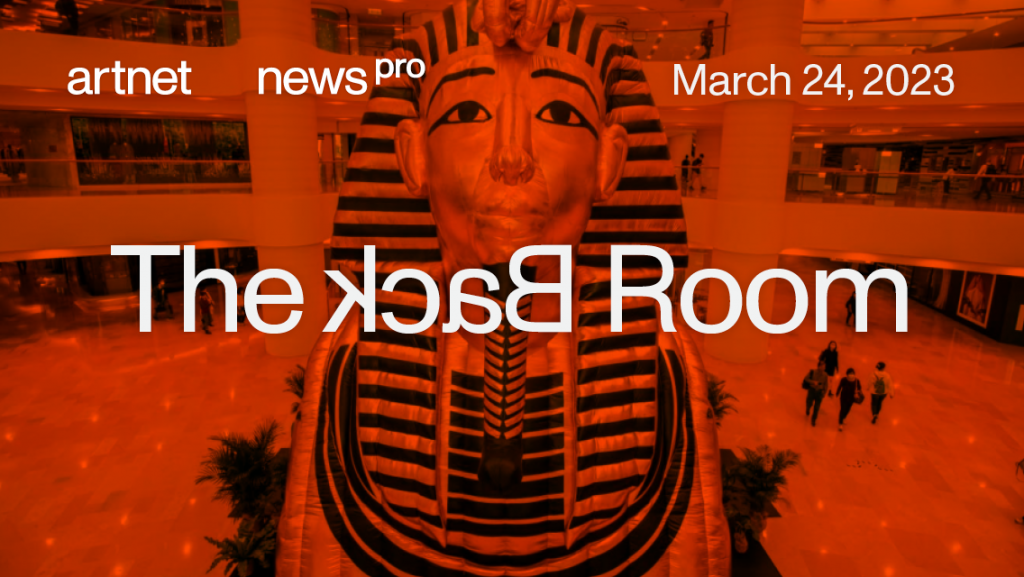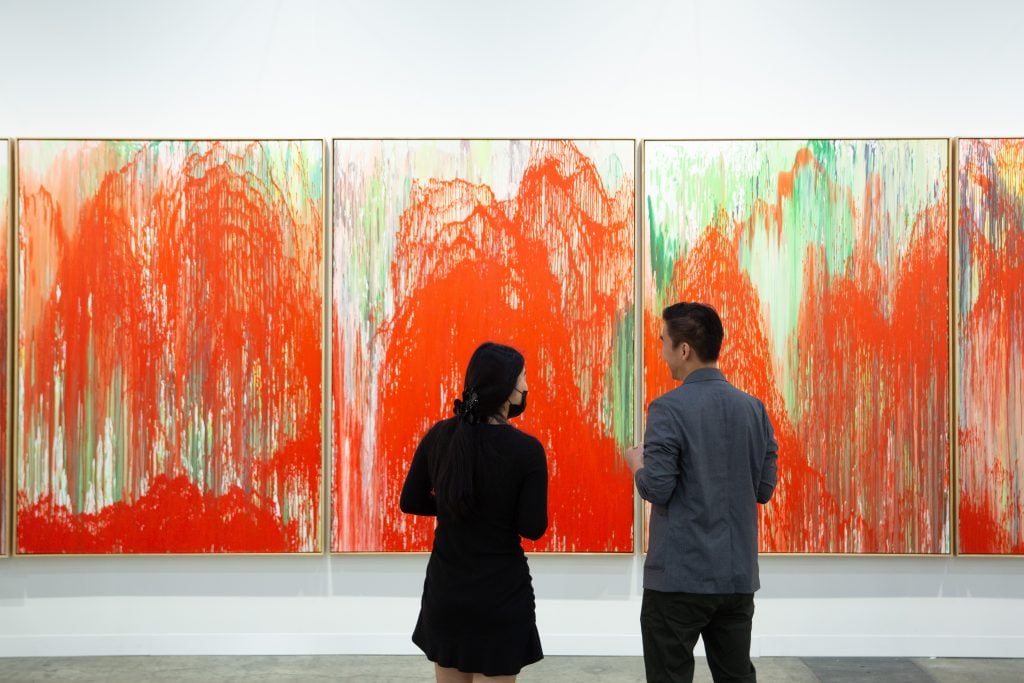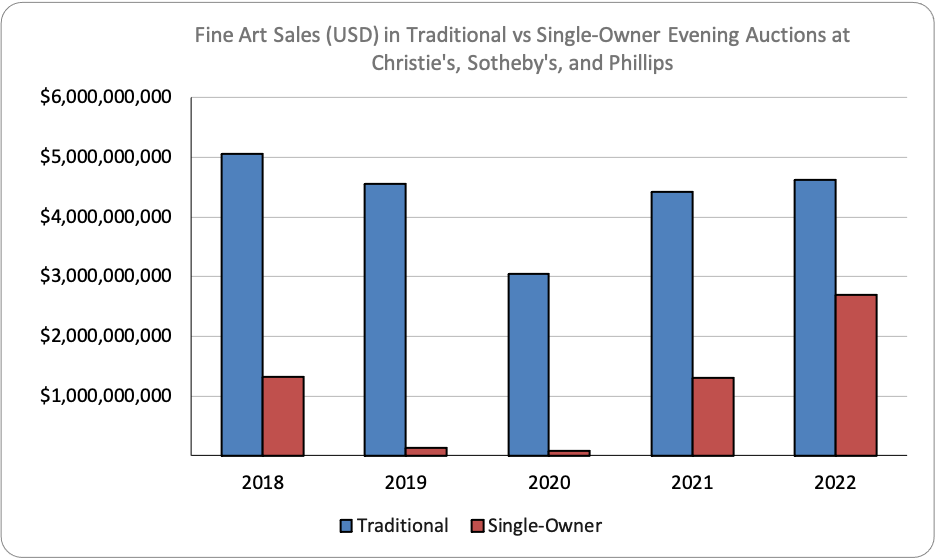The Back Room
The Back Room: Answering Hong Kong’s Riddle
This week: the intrigue around ABHK’s return, a new art-world power couple emerges, the rise of single-owner auction action, and much more.

This week: the intrigue around ABHK’s return, a new art-world power couple emerges, the rise of single-owner auction action, and much more.

Artnet News

Every Friday, Artnet News Pro members get exclusive access to the Back Room, our lively recap funneling only the week’s must-know intel into a nimble read you’ll actually enjoy.
This week in the Back Room: the intrigue around ABHK’s return, a new art-world power couple emerges, the rise of single-owner auction action, and much more—all in a 7-minute read (1,983 words).
__________________________________________________________________________

Richard Koh Fine Art at Art Basel Hong Kong 2023. Courtesy of Art Basel.
Could Art Basel Hong Kong ever feel as lively post-Covid as it did pre-Covid?
Art professionals have had much too long to puzzle over this question. On Wednesday, for the first time in three years, the fair opened free of the draconian quarantine measures that have either fully or largely sealed it off from the rest of the world since its canceled 2020 edition.
The answer to the riddle now seems clear: Hong Kong’s most prestigious fair is back in a big way, and its art-market infrastructure still looks like the crown jewel of Asia.
Neither conclusion was a given based on events in the intervening years. Aside from Hong Kong’s hermetic enclosure due to Covid concerns, the city suffered a brain drain after China imposed a wide-ranging national security law in 2020, reducing Hong Kong’s autonomy, clamping down on its free press, and increasing prosecutions of its pro-democracy protesters.
Meanwhile, nearby cities Seoul, Singapore, and even Tokyo upped their international art-market game by launching new fairs and signal events in a bid to fill the vacuum left by a locked-down, increasingly illiberal Hong Kong.
If that weren’t enough, the largest global banking crisis since 2008 began unfolding in the weeks preceding ABHK’s return, stoking jitters in the investing (and collecting) class from the U.S. to Switzerland and beyond.
Nevertheless, the contextual turmoil was swept under the red carpet this week, as the fair’s array of well-appointed dinner tables, well-attended parties, and well-stocked sales reports have made 2023 feel an awful lot like 2019.
Sources on the sales floor reported aisles crowded by local heavyweights such as Alan Lo, mainland Chinese whales such as Liu Yiqian, and—in a vital return to form—big-time buyers from the international art circuit, ranging from Maja Hoffmann to Sheikha al-Mayassa.
True, the number of participating galleries this year (177) was still down 27 percent from the 2019 fair (242). But as Artnet News contributor Frederik Balfour noted in his report, Covid restrictions in Hong Kong were still in place when the application deadline closed last June.
That wrinkle might very well mean that the momentum will only intensify at next year’s fair, especially in light of the results and energy from this week’s edition. Here are our main takeaways about the state of play based on early sales…
The three loftiest deals confirmed by Thursday were as follows:
Each of the above was much richer than its top-three counterpart at the 2019 fair’s close:
The discrepancy is much more than inflation can account for, suggesting that a real thirst for apex-level primary works has been waiting for an outlet of ABHK’s caliber. Also telling: this year’s top sales blew past their equivalents at the inaugural Frieze Seoul, which maxed out at $2.8 million.
That said…
This price bracket dominated the flurry of first-day sales reports outside the very top shelf of galleries. For example:
These approachably priced deals were struck for works by artists whose ages ranged from their 20s to their 60s, speaking to many regional collectors’ focus on research and value (and perhaps their wariness of a still-shaky economy). However…
Sources reported that several Asian buyers continue to scramble for hot young names, no matter their cost or ethnic identity. (We define ultra-contemporary artists as those born in 1979 or later.) Consider these sales:
While sales for works by young artists of Asian heritage were certainly prevalent, the subjects of demand at ABHK felt more diverse than ever. One clear embodiment was the arrival of the fair’s first-ever galleries based in Africa: SMAC (Cape Town) and Retro Africa (Abuja, Nigeria).
__________________________________________________________________________
Despite years of hand-wringing and second guessing, this week has proven that Hong Kong remains Asia’s pivot point in the global art trade. That’s no slight to Seoul, Singapore, and Tokyo, just an acknowledgment of how large a lead Hong Kong had established in the decades pre-Covid.
The depth on the buy and sell sides of the city’s art market remains unrivaled in the region. Its taxes remain low, its commercial regulations light, and its status as a freeport advantageous.
Art businesses across sectors are also still betting big on Hong Kong’s year-round strength. The Big Three auction houses have all either opened (Phillips) or announced (Christie’s and Sotheby’s) lavish expansions in the city. Membership in the Hong Kong Art Gallery Association has jumped nearly 27 percent since 2021. Homegrown institutions like M+ are finally welcoming the international audiences they’d long envisioned.
None of the above guarantees that Hong Kong will always be the central hub of the international art market in Asia. But Art Basel Hong Kong 2023 will go down as a strong reminder that the city’s competitors in the region can’t catch up overnight—or even after three troubled years.
____________________________________________________________________________
The latest Wet Paint has the scoop on the art world’s newest power couple: Kennemin, aka Artnet News’s own Kenny Schachter x Tracey Emin. Plus, a tour through the unexpected, complicated impact of the Adderall shortage on our niche industry.
Here’s what else made a mark around the industry since last Friday morning…
Art Fairs
Auction Houses
Galleries
Institutions
Tech and Legal News
____________________________________________________________________________
“The crazy thing about the art business is that what I did is common practice… But the business is so secretive, and so opaque, that even though lies and fraud are rampant, no one gets in trouble. Except, it turns out, a schmuck like me.”
—New York dealer Ezra Chowaiki, newly off probation following an 18-month prison stint for wire fraud, on the “gorgeous cesspool” that is the art industry. (Airmail)
____________________________________________________________________________

© 2022 Artnet Worldwide Corporation. Source: Artnet Price Database and Artnet Analytics.
One of the most noteworthy trends in the fine art auction sector over the past half-decade has been the growing importance of single-owner evening sales. The category generated record revenue last year, and its outperformance was highlighted in a recent deep dive into annual fine art auction data by Artnet News, the Artnet Price Database, and Morgan Stanley.
With Christie’s announcing a potentially $270 million single-owner evening sale as part of its May auction cycle in New York (as noted in Paint Drippings), there’s little evidence to suggest this trend is going away anytime soon.
—Tim Schneider